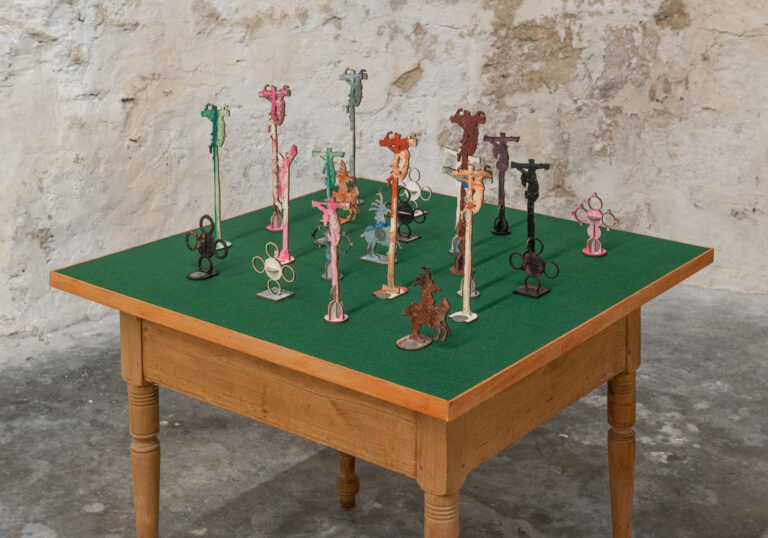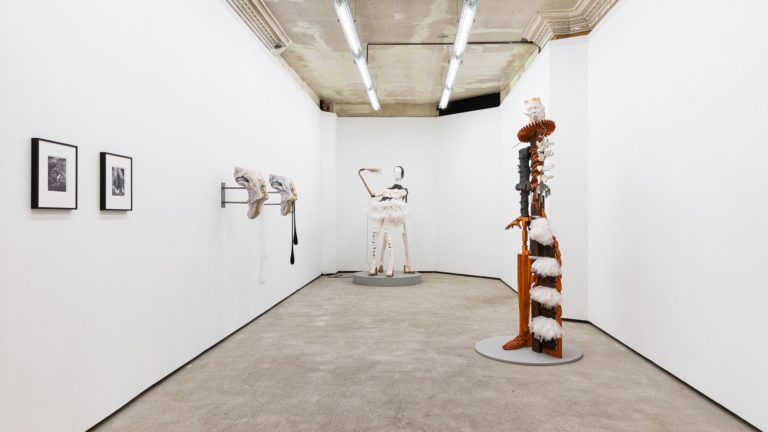Artist: Valentin Dommanget
Exhibition title: ESC(ape)/CTRL
Curated by: Domenico de Chirico
Venue: Lily Robert, Paris, France
Date: February 1 – 28, 2018
Photography: all images copyright and courtesy of the artist and Lily Robert, Paris
Lily Robert is pleased to announce ESC(ape)/CTRL, Valentin Dommanget’s second exhibition with the gallery, curated by Domenico de Chirico.
In his second solo exhibition, Valentin Dommanget shows a profound evolution in his practice, and changes that mainly concern associations and visions that one may have towards the outside and possible social exchanges. The young French artist – who has always worked in the field of abstraction and having now internalised an aesthetic of digital reference that embraces the geological sciences and the hypercolor, the natural and the artifcio – in these new works also inserts human figures. He does this in order to analyse the interferences to which humanity in general is continually subjected and the new complexities arising in the distorted contemporary moment, in which a phantomatic and latent dark force tries to make us believe in the emptiness and lack of logic of content dissolving our minds through the saturation of data administered daily.
The theme of transhumanism gains increasing significance in this new body of work. The binomial Human/Machine developed through the use of randomness in painting and the use of software seems to lose the sense of a conceptual gap. The separation of these two entities is understood as a misunderstanding and the concept becomes simpler and more effective. The pursuit of artificial intelligence could be an evolution of the human brain, therefore technology as a concept or stage of this evolution is no longer conceived as something to separate from the natural progress of the human being. In fact, Transhumanism, sometimes abbreviated with the formula > H or H+ or H-plus, is a cultural movement that supports the use of scientific and technological discoveries to increase physical and cognitive skills and in view of a posthuman transformation, improve aspects of the human condition which are considered undesirable, such as disease and aging. It is believed that the term “transhumanism” was coined by the British biologist, geneticist and writer Julian Huxley in his 1957 text “In New Bottles for New Wine” in which he imagined scenarios for the emancipation of humanity. Huxley originally conceived transhumanism as “the man who remains human, but who transcends himself, realising the new potentialities of his human nature, for his human nature;” “Transhumanism shares many elements with humanism, including respect for reason and the sciences, the commitment to progress and to value human (or transhuman) existence in this life.”
Dommanget is not creating a bridge between mankind and computers, but rather seeking the reality of these extensions in changes in our traditions and social behavior directly in the status quo. Artificial means being created by man, and if we actually accept that humans are nature, then artificial is nonsense. It is fundamental that we understand that man, because of his nature, is driven to the artificial. Evolution itself is natural and with it the progress of human intelligence in material and virtual ways. The works caress this rift, smoothing it, raising the material to the virtuosity of the virtual and the virtual to the flesh of matter. There is a reflection on the meaning of spirituality in a time when the machine can either cancel humanity or live in harmony with it.
Domenico de Chirico, 2018
Notes :
*a b c Sapere.it, “Transumanesimo”
*Huxley, Julian, In New Bottles for New Wine, Chatto & Windus, 1957
*Wikipedia




























